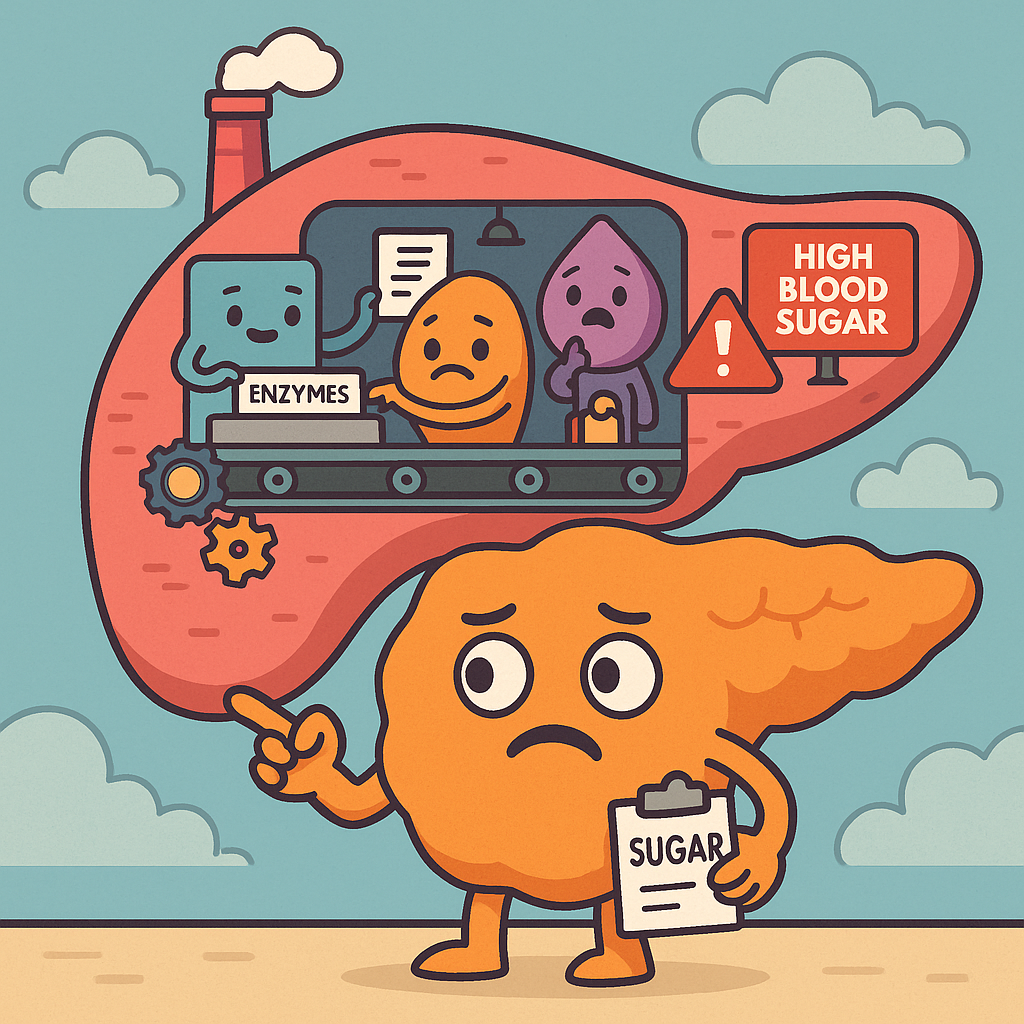🩺 Behind the Scenes of Digestion: The Power and Problems of the Pancreas

Health & Sciences | The Varrock Street Journal
Hello again wonderful readers of the Varrock Street Journal!
Nestled deep in your abdomen, hidden behind the stomach, sits an organ you probably don’t think about often—until it causes a problem. The pancreas might be one of the most underappreciated yet essential organs in the human body. From regulating blood sugar to aiding digestion, this dual-function powerhouse is both an endocrine and exocrine organ.
In this edition, we’re taking a closer look at what the pancreas does, what happens when it goes wrong, and why diseases like pancreatitis, diabetes, and pancreatic cancer deserve more attention.

🔬 What Does the Pancreas Do?
The pancreas has two major jobs:
- Endocrine function – It releases hormones like:
- Insulin, which lowers blood sugar
- Glucagon, which raises blood sugar
- These hormones are made by clusters of cells called islets of Langerhans
- Exocrine function – It produces digestive enzymes (amylase, lipase, protease) that are sent to the small intestine to break down carbohydrates, fats, and proteins.
So, the pancreas doesn’t just regulate your blood sugar—it also helps you absorb the nutrients from your food.

⚠️ Common Pancreatic Pathologies
1. Diabetes Mellitus
- Type 1 Diabetes: An autoimmune condition where the immune system destroys insulin-producing cells in the pancreas.
- Type 2 Diabetes: A condition where the body becomes resistant to insulin or doesn’t produce enough, often linked to lifestyle and genetics.
- Both types lead to high blood sugar, which can damage nerves, blood vessels, and organs over time.
2. Pancreatitis
- Inflammation of the pancreas, which can be acute or chronic.
- Causes include gallstones, alcohol use, certain medications, and trauma.
- Symptoms: Severe abdominal pain, nausea, vomiting, and fever.
- Chronic pancreatitis can lead to permanent damage and digestive problems.
3. Pancreatic Cancer
- One of the most deadly cancers due to its subtle onset and late detection.
- Common symptoms include weight loss, jaundice, abdominal pain, and loss of appetite.
- Risk factors: Smoking, chronic pancreatitis, family history, obesity, and certain genetic syndromes.
4. Pancreatic Cysts and Pseudocysts
- Fluid-filled sacs that can form after inflammation or injury.
- Most are benign but may need to be monitored or drained if symptomatic.
5. Cystic Fibrosis (CF) and Exocrine Pancreatic Insufficiency
- In CF, thick mucus blocks pancreatic ducts, leading to poor enzyme release.
- Patients may have trouble digesting fat and absorbing vitamins.
🧪 How Is Pancreatic Disease Diagnosed?
Because of its deep location in the abdomen, pancreatic issues can be hard to detect early. Diagnostic tools include:
- Blood tests: Amylase, lipase, glucose, and insulin levels
- Imaging: CT scans, MRI, and endoscopic ultrasound (EUS)
- ERCP (Endoscopic Retrograde Cholangiopancreatography): to view ducts
- Biopsy or aspiration of cysts or masses if needed
💊 Treatment Approaches
Treatment depends on the condition:
- Diabetes: Managed with insulin, medications, diet, and lifestyle changes
- Pancreatitis: Often treated with IV fluids, pain management, fasting, and treating the cause
- Pancreatic cancer: Surgery (like Whipple procedure), chemotherapy, or radiation depending on stage
- Pancreatic enzyme replacement therapy (PERT): For those with digestive insufficiency
- Lifestyle modifications: Avoiding alcohol, smoking cessation, healthy diet
🧠 Why This Matters
The pancreas plays a central role in metabolic and digestive health, yet many people are unaware of its function until it becomes diseased. With early recognition and modern tools, many pancreatic conditions are treatable or manageable.
Awareness is key—because catching pancreatic issues early can save lives.
🌟 Spotlight on the Future
- Artificial pancreas systems are improving diabetes care through automated insulin delivery.
- Liquid biopsy research may allow for earlier detection of pancreatic cancer via blood tests.
- Stem cell therapy for regenerating insulin-producing cells is under development.
- New enzyme formulations are improving nutrition in patients with chronic pancreatic insufficiency.
😲 Did You Know?
- The pancreas produces about 1.5 liters of digestive enzymes every day.
- Pancreatic cancer is often called a “silent killer” because symptoms rarely appear early.
- Your pancreas can still function with as little as 10% of healthy tissue remaining.
This is a neat podcast with various episodes discussing the pancreas. In honor of fathers day, here is an episode they featured!
🧠 Reflection Questions
- How does understanding the pancreas change how you view your digestive and metabolic health?
- Should routine screening be expanded for pancreatic disease, especially in high-risk groups?
- How can technology help catch pancreatic problems earlier?
👋 Final Thoughts
The pancreas may work in silence, but when it speaks, we must listen. Whether it's balancing blood sugar, digesting dinner, or warning us of serious disease, this small organ deserves big respect.
📚 References
- American Diabetes Association. (2024). Understanding Pancreatic Function and Diabetes. https://www.diabetes.org
- National Pancreas Foundation. (2024). Pancreatic Diseases. https://pancreasfoundation.org
- Mayo Clinic. (2024). Pancreatic Cancer and Chronic Pancreatitis Overview. https://www.mayoclinic.org
- Cleveland Clinic. (2024). Your Guide to the Pancreas. https://my.clevelandclinic.org
📲 Stay balanced with us every week:
- Instagram: @thevarrockstreetjournal
- TikTok: @varrock.street.jo
